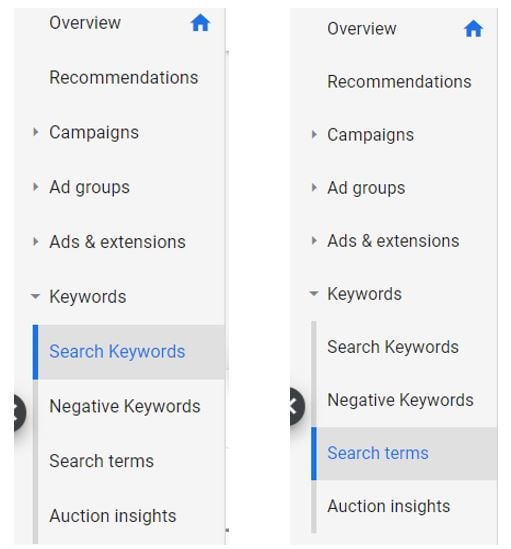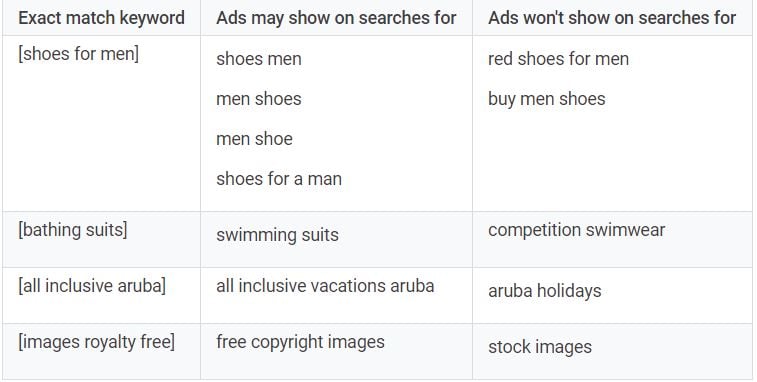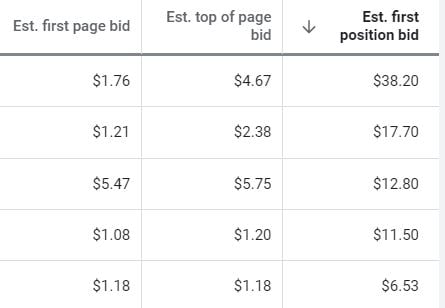In the world of PPC advertising nothing could be more important than keywords. This is where everything starts. Bids are set at the keyword level, as well as the Quality Score. Your ad rank is also determined at the keyword level. You pay per clicks than happen on ads triggered by your keywords.
With this article you'll get a complete overview of how to manage keywords in Google Ads.
Table of Contents
Keywords vs Search Terms
Keyword Matching Options
The Search Terms Report
Negative Keywords
Keyword Research
Keyword Strategies
Start with broad Short-Tail Keywords
Place Your Medium/Long-Tail Keywords in Separate Ad Groups
Group Your Keywords by Purchase Intent
How the Role of Keywords Has Changed
How to Bid on Keywords
Manual Bidding
Semi-Automated Bidding
Fully-Automated Bidding (or Smart Bidding)
Conclusions
Keywords vs Search Terms
First things first. We need to make a very important distinction. Keywords are not the same as search terms, although they are strictly interconnected.
In fact, you can find them under two different tabs in the Google Ads platform.

Search Terms are equal to the search queries users perform on Google. When I look for "best feed management software" on Google, I am performing a search query. This is called Search Term in Google Ads.
Keywords are what you manually upload onto your Google Ads account and will be triggered by users' search queries.
The search query "best feed management software" might trigger my keyword "feed management software". You might have noticed that the keyword is not exactly the same as the search query.
In fact, keywords are not only triggered by the exact same search term. They might be triggered by a whole variety of search terms, based on some criteria that we are going to explore in the next section of this article.
Keyword Matching Options
Keyword matching options, or match types, are the criteria used to determine which keyword search terms should trigger.
There are 4 match types: Broad Match, Broad Match Modifier, Phrase Matchand Exact Match.
Here you'll find the official Google definitions:
Broad Match:
"Broad match is the default match type that all your keywords are assigned. Ads may show on searches that include misspellings, synonyms, related searches, and other relevant variations. So if your keyword is “women’s hats,” someone searching for “buy ladies hats” as well as “women’s scarves” might see your ad".
Broad Match Modifier:
"Similar to broad match, except that the broad match modifier option only shows ads in searches that include the words with a plus sign “+” in front of them (+women’s hats), or close variations of the “+” terms".
Phrase Match:
Ads may show on searches that match a phrase, or close variations of that phrase, which may include additional words before or after. Ads won't show, however, if a word is added to the middle of the phrase that changes the meaning of the phrase. Phrase match is designated with quotation marks ("women's hats").
Exact Match:
"Ads may show on searches that match the exact term or are close variations of that exact term. Close variants include searches for keywords with the same meaning as the exact keywords, regardless of spelling or grammar differences between the query and the keyword. Exact match is designated with brackets [red shoe]".
After reading this you would better understand the difference between Keywords and Search Terms.
Depending on the Match Type you use, different Search Terms might trigger your Keywords. If you want exactly the same Search Term as your Keyword, then you should use the Exact Match Type. If you feel like you can be a bit broader, you can opt for Phrase Match or Broad Match Modifier. If you are curious to know more, here you can read about the latest Google update regarding query matching.
The Search Terms Report
It is essential that you always consult the Search Terms Report. You can access it by clicking on Keywords and then Search Terms on the left side menu. You can see search terms at the account, campaign and ad group level.
The Search Terms Report shows exactly what search queries triggered your keywords. Because of the several match types you've just learnt about, it is possible that not every search term is actually relevant to your product or service.
For example, my keyword "feed management software" in Phrase Match might trigger the search term "feed management software for Pinterest Ads". We at DataFeedWatch offer this service, but it might not be your case. Maybe your software only covers Shopify and Amazon.
Therefore, you want to make sure that people looking for "feed management software for pinterest ads" won't find you. Otherwise, they might click on your ad and then leave your website straight after as they don't find what they were looking for. You would just waste precious ad budget.
You should go through your search terms report at least once a week. You never know what you might find!
How can you actually make sure that people looking for the Pinterest Ads feed software won't find you? With Negative Keywords!
Negative Keywords
Negative Keywords are sometimes considered as the fifth match type. However, because of their importance and different use, it worth focus on them in a separate section.
Google defines them as "A type of keyword that prevents your ad from being triggered by a certain word or phrase. Your ads aren’t shown to anyone who is searching for that phrase"
In this case, the negative keyword I need to use is "pinterest". In fact, if I do sell feed management software, but nothing about Pinterest, I might as well remove any search term that includes the word "pinterest".
A very common negative keyword that many advertisers add to their accounts almost by default is "free". For example, some feed management software might be open-source and therefore free. Some people might be looking for "free feed management software". Well, if your software is not free, you need to add "free" as a negative keyword.
Negative Keywords can be set at the account, campaign and ad group level. It's a bit different in Performance Max, where the process of adding them is a bit more complex as of today.
For example, if you don't sell free products or services, you might set the negative keyword "free" at the account level. So it will be shared by any campaign or ad group in the account, even the ones that you will create in the future.
On the other hand, if you do not sell a Pinterest Ads feed management software, but maybe you do sell some Pinterest Ads consulting services, you might add the "pinterest" negative keyword only at the campaign or ad group level.
Your ideal workflow should look like this:
Check the search terms report > add new negative keywords
You should always add negative keywords based on your search terms report. Avoid the guessing game.
Keyword Research
Sometimes it happens that instead of finding words that you need to exclude, you actually find useful terms that you haven't thought of.
In this case, you might want to add those terms to your "positive" keyword list. This is one of the best ways to conduct keyword research and make sure that your keywords are actually relevant for your business.
Obviously, if you're just starting out your search terms report will be empty. But as soon as the account gets a bit of historical data, even a few days would be enough, then it is time to check the search terms report and update your keywords.
What keywords are better than those that your customers are already looking for!
If you're launching a new product or service or you're just starting with a new account and your search terms report is not helpful, you can use the Google Keyword Planner to get initial ideas on what keywords to use.
You can find the Keyword Planner in the main "Tools & Settings Menu".
The Keyword Planner helps you discover new keywords and find new ideas, as well as get search volume forecast for a given set of keywords.

This is a perfect place to start!
Alternatively, you can use other third-party tools like Keywordtool.io or SEMrush.
Also, don't forget that Google is your best friend!
Simply search for relevant terms on Google and see what results come up. Chances are that the wording used in your competitors' ads is the same that you can use for your new keywords!
Therefore, when it comes to researching new keywords, our advice is to use a combination of the methods above. Always look for a second opinion :)
Keyword Strategies
Now that you learnt about the Keyword Match Types, the Search Terms Report, the Negative Keywords and how to research for new keywords, let's get a bit deeper about how you can turn all this knowledge into a Google Search Ads strategy.
Start with broad Short-Tail Keywords
If you're just starting out with a new account, product or service, you still might not know how your ads will behave and what users actually look for. Basically you still need to gather enough Serch Terms data.
The best and quickest way to gather this data is by starting with broad match modifier keywords.
Broad match modifier is an excellent match type as it gives the flexibility of broad keywords, but at the same time it makes sure that all words are actually included in the search term.
For example, say you are selling guided tours in Sydney. You're just starting and you are not sure of what potential customers actually look for. They might be looking for "guided tours in sydney" or "sydney tours" or "sydney day tours" etc
What you need to do here is starting with a "+sydney +tours" broad match modifier keyword. This keyword will match with any search term that includes the words "sydney" and "tour". This is quite broad, but it is perfect to start with!
After a few days, you will be able to check the search terms report and see what people looked for when they found your ad.
You might find out that they were looking for "sydney opera house tour" or "syndey full day tour", or "sydney boat tour".
Now, if you do sell Sydney Opera House tours and Sydney full-day tours, then you might want to add those keywords to your list. On the other hand, if do not sell Syndey boat tours, then you need to add "boat" as a negative keyword.
What to do next?
Place Your Medium/Long-Tail Keywords in Separate Ad Groups
Now that you added "sydney opera house tour" and "syndey full day tour" to your list you might be wondering what match type you should use in this case.
Since you know for sure that potential customers look for these terms, because you spotted them in the search terms report, you might add them as Exact Match. The Exact Match Type narrows down the field and makes sure that only relevant search terms trigger your keyword. The more your keywords are relevant and closer to the search terms, the higher their quality score and possibly the lower their cost-per-click.
Now, in order to take full advantage of this virtuous circle that Exact Match keywords trigger, you need to place them in separate ad groups.
For example, [sydney opera house tour] and [syndey full day tour] should stay in different ad groups. In fact, these keywords probably refer to different products that have different landing pages on your website. Therefore, even the ads for these products should have a different copy and a different landing page.
As a rule of thumb, we can say that whenever you feel the need to use different landing pages, then you should also use different ad groups.
Following the previous example, your Sydney Tours campaign will look like this:

Every time you find new long-tail keywords you should create a new ad group specifically for those.
This way you will steer your potential customers to the most relevant ad and landing page combination, increasing chances of getting a conversion.
Because the keywords' Quality Score is determined by their relevance to the ad and landing page, this is a great strategy to increase the score and therefore decrease the cost per click.
In fact, the Google Ads algorithm works in a way that the higher the Quality Score, the lower your cost per click and the higher your ad rank.
Group Your Keywords by Purchase Intent
In the previous section we saw how to group keywords based on the different products you sell.
Potentially, there is another way to group keywords that you can use alongside the aforementioned one. You can group keywords based on their purchase intent.
In fact, some broader keywords drive more generic and informational search terms, while long-tail keywords might have a higher purchase intent.
For example, the keywords [sydney opera house tour] and [how to book a sydney opera house tour] have very different intents, although they are both long-tail and in exact match.
The second keyword is more likely to drive a sale as whoever is looking for that search term is literally looking to book a tour as soon as possible. On the other hand, the first keyword might attract people who are just looking for information rather than to book a tour.
Keep this in mind!
How the Role of Keywords Has Changed
In the early stages of Google Ads (formerly known as Google AdWords), keyword match types were very defined and exact match literally meant exact match. No variations were allowed.
Over the last few years, Google has changed the role of the exact match type making it broader. In fact, nowadays the exact match type also includes closed variants.
Example:

Therefore, there are now less exact-match keywords you should add to your ad groups, as one keyword accounts for a broader range of search terms.
It is even hard to talk about "exact match" in 2020 and some PPC managers even advise not to use it at all. It is up for debate.
As usual, test it out before making up your mind!
How to Bid on Keywords
Together with the Quality Score, keywords' bids determine your ad rank.
When it comes to bidding you have three choices.
- Manual bidding
- Semi-Automated bidding
- Fully-Automated bidding
Google Ads offer several different bid strategies, but we are going to focus on the main ones.
Manual Bidding
This is the default option and, as the name says, it allows you to fully manage your bids manually. How should you manage your bids?
Keywords' bids essentially represent how much you are ideally willing to spend for a click. Therefore, they should be based on your budget availability. It goes without saying that the higher your budget, the more you are potentially able to spend per click.
Your bids should also be managed taking the competition into consideration. The tougher the competition, the more expensive keywords will be.
When it comes to asses the level of competition you can check a metric called Search Impression Share. "Impression share (IS) is the percentage of impressions that your ads receive compared to the total number of impressions that your ads could get." The impression share is expressed as a percentage. An IS of 60% means that your ads showed up only 60% of the times they were eligible to. What happened in the remaining 40%? Well, a competitor showed up in your place. So the lower your impression share, the tougher the competition.
Based on your impression share you can decide whether to raise or decrease your bids. If your impression share is low and you feel like you have money to invest, then raising your bids could be a good idea. On the other hand, if you reckon you've maxed out your budget, you should then try to improve your Quality Score instead of raising your bids.
You can check the impression share at the keyword level, so you can make an informed decision for each keyword.
Another strategy could be to raise your bids to their estimate for the first page, top of page or first position bid.
You can add the columns like shown in the screenshot and then use the estimates as a guide.

Semi-Automated Bidding
There is only one bidding strategy that belongs to this category. It is the Enhanced CPC bid strategy (eCPC).
"ECPC works by automatically adjusting your manual bids for clicks that seem more or less likely to lead to a sale or conversion on your website."
With this strategy, you still set your bids manually, but the system adjusts them, either raising them or even setting them to zero if it reckons so. This is an excellent compromise between a fully manual and a fully automated solution.
If you are using manual bidding we recommend you switch to eCPC before moving to fully automated strategies.
Fully-Automated Bidding (or Smart Bidding)
Many bidding strategies belong to this category, but we want to focus on the most suited to eCommerce businesses: Target ROAS.
With the Target ROAS bid strategy the system automatically changes your bids in order to achieve a target return on the ad spend (ROAS) that you can set at the campaign or ad group level.
ROAS is the ratio between revenue and cost and it is expressed as a percentage.
If your goal is to achieve a 700% ROAS, the system will set your bids so your revenue will be 7 times your cost. This might mean bidding more aggressively in order to get more revenue at the same cost or even bid less aggressively in order to spend less but keep the same level of revenue.
Managing a Target ROAS campaign is all about finding the right balance between the ROAS target and the campaign daily budget.
This bidding strategy is very relevant for eCommerce businesses because it aims at revenue rather than conversions. Whoever works in eCommerce knows well that every conversion might have a very different value depending on what products were purchased. Therefore, aiming at conversions wouldn't be enough. The eCommerce PPC manager's goal is to maximise revenue, not necessary conversions.
If you have enough volume of traffic and conversions with a decent budget, we recommend you take this strategy into serious consideration.
Next Recommended Read: What is automated bidding in Google Ads?
Conclusions
You now have a good understanding of keywords in Google ads!
Keywords are the engine that runs Google Ads and therefore it is essential that you are able to maintain it with regular checks and updates. From adding new keywords and removing non-performing ones, to updating negative keywords and changing bids, it is an ongoing optimization work that is essential for Google Ads success!

